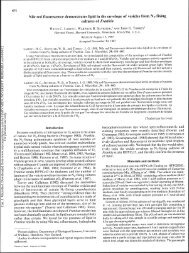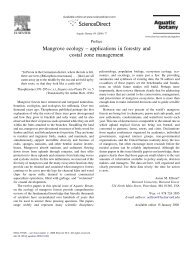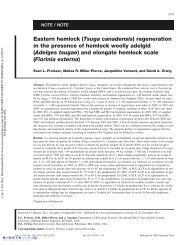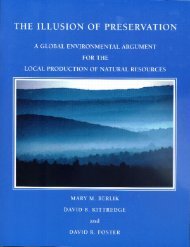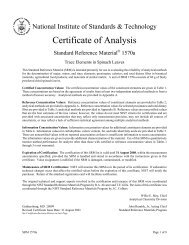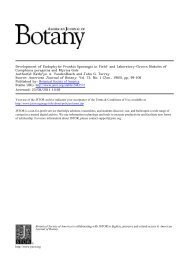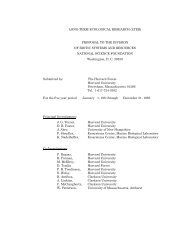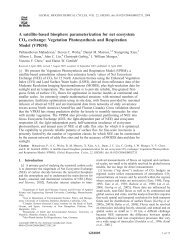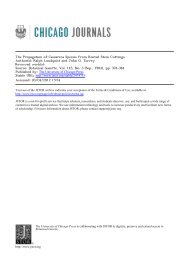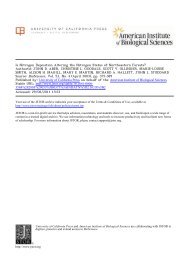Abstracts of Papers - Harvard Forest - Harvard University
Abstracts of Papers - Harvard Forest - Harvard University
Abstracts of Papers - Harvard Forest - Harvard University
Create successful ePaper yourself
Turn your PDF publications into a flip-book with our unique Google optimized e-Paper software.
4) In mixtures, the competitively superior species<br />
shows a relatively low degree <strong>of</strong> inequality, while<br />
the competitively inferior species shows high<br />
inequality.<br />
The results support the dominance/suppression<br />
model <strong>of</strong> plant competition.<br />
Symposium: The Mire - Wetland Ecosystem<br />
INTRODUCTION<br />
Wetland and mire ecosystems possess a unique set <strong>of</strong><br />
characteristics that differentiate these systems from<br />
both terrestrial and aquatic habitats. The abundant<br />
research that has been done in Europe in these eco-<br />
systems is in marked contrast to the state <strong>of</strong> our<br />
knowledge in North America. However, in the past<br />
decade or so, significant work has been completed in<br />
the United States and Canada. This symposium hopes<br />
to examine some <strong>of</strong> this recent research and present<br />
the status <strong>of</strong> our knowledge <strong>of</strong> these ecosystems.<br />
Organized by Dale H. Vitt, <strong>University</strong> <strong>of</strong> Alberta,<br />
Edmonton, Alberta and Bruce Roberts, Canadian <strong>Forest</strong>ry<br />
Service, St. John's Newfoundland.<br />
ANDRUS, RICHARD E. Department <strong>of</strong> Biological<br />
Sciences, State <strong>University</strong> <strong>of</strong> New York at<br />
Binghamton, N.Y. 13901.<br />
- The ecology <strong>of</strong> Sphagnum.<br />
Sphagnum species are ecologically unusual and prom-<br />
inent wetland plants with xerophytic adaptations<br />
and succession-directing acidification capabilities.<br />
Species are differentiated along environment gra-<br />
dients <strong>of</strong> pH, cation concentrations, hummock and<br />
hollow, wet vs. dry, shade vs. sun, coastal vs. in-<br />
land and cold vs. warm. The known factors respon-<br />
sible for gradient differentiation include cation<br />
exchange capacity, desiccation tolerance, desicca-<br />
tion resistance, water-holding capacity, drying<br />
rates and photosynthetic response at differing water<br />
contents. Small-scale distribution <strong>of</strong> Sphagnum<br />
species on ombrotrophic sites can be partially ex-<br />
plained but for minerotrophic sites, where acid<br />
precipitation influence is greatest, less is known.<br />
BAYLEY, SUZANNE. Freshwater Institute,<br />
501 <strong>University</strong> Crescent, Winnipeg, Manitoba.<br />
R3T 2N6<br />
- Comparisons <strong>of</strong> nutrient relationships in<br />
freshwater wetlands from Canada to Florida.<br />
Nitrogen and phosphorus dynamics in southern<br />
swamp forests and fresh water marshes are compared<br />
to northern bogs, fens, and marshes. Latitudinal<br />
differences in nitrogen and phosphorus content <strong>of</strong><br />
vegetation, nutrient concentrations <strong>of</strong> surface<br />
and pore water, and annual nutrient uptake are<br />
not apparent in the data reviewed. Substrate and<br />
hydrologic regimes appear to be more important.<br />
Vegetation on organic substrates contains less<br />
nitrogen and phosphorus in the above ground<br />
biomass (Wigham and Bayley 1978). Cypress<br />
wetlands in higher water flow contain higher<br />
concentrations <strong>of</strong> phosphorus in above ground<br />
biomass (Brown 1981). Other wetlands appear to<br />
follow the same trend. The ability <strong>of</strong> a wetland<br />
to retain added nutrients depends upon the<br />
hydrologic regime and organic substrate.<br />
Ecological Section 39<br />
CARTER, VIRGINIA U.S. Geological Survey, 431<br />
National Center, Reston, VA 22092 - Wetlands <strong>of</strong><br />
the United States- ecology, hydrology, and research<br />
needs.<br />
The wetlands <strong>of</strong> United States can be subdivided into<br />
classes, subclasses, and dominance types on the basis<br />
<strong>of</strong> vegetation, hydrology and soils using the "Classi-<br />
fication <strong>of</strong> Wetlands and Deep Water Habitats" by<br />
Cowardin et al. (1979). There is a tremendous<br />
diversity in wetland types and wetland vegetation in<br />
the United States, caused primarily by regional<br />
topographic and climatic differences. Wetland<br />
hydrology, a primary driving force influencing<br />
wetland ecology and wetland development and persis-<br />
tence, is as yet poorly understood. The interaction<br />
between ground water and surface water, and the<br />
discharge-recharge relationships in wetlands<br />
influence water quality and nutrient budgets as well<br />
as vegetative composition. Anthropogenic influences,<br />
such as construction <strong>of</strong> drainage canals, diversions,<br />
storage areas and industrial facilitites, or mining<br />
<strong>of</strong> peat may have unforseen hydrologic consequences<br />
because <strong>of</strong> our lack <strong>of</strong> knowledge <strong>of</strong> water movement<br />
and water budgets. Expanded research and basic data<br />
collection are needed to manage and protect wetlands<br />
effectively.<br />
DAMMAN, ANTONI W.H. Ecology Section, Biological<br />
Sciences Group, <strong>University</strong> <strong>of</strong> Connecticut,<br />
Storrs, CT 06268.<br />
- Ecological processes in ombrogenic peat bogs<br />
Ombrogenic peat bogs differ from soligenic and<br />
topogenic peatlands in their hydrology and associated<br />
differences in water chemistry, organic matter<br />
accumulation and vegetation. The hydraulic potential<br />
is positive in most <strong>of</strong> the raised peat mass, and<br />
water flow is primarily through the relatively<br />
undecompsed surface peat. The extreme nutrient-<br />
deficiency <strong>of</strong> ombrotrophic peat and the growth <strong>of</strong><br />
the Sphagnum carpet create conditions for release<br />
and accumulation <strong>of</strong> elements which are fundamentally<br />
different from those on minerotrophic sites. In<br />
ombrotrophic parts <strong>of</strong> these peatlands, productivity<br />
affects peat accumulation, but on minerotrophic<br />
sites decomposition overrides differences in<br />
productivity and peat does not accumulate to any<br />
significant degree above the water level. Potassium,<br />
and to a lesser degree Ca, concentrations show<br />
seasonal fluctuations in the drainage water with<br />
high concentrations in spring and autumn, and<br />
concentrations far below that <strong>of</strong> the precipitation<br />
during the summer. Na and Mg concentrations remain<br />
5-10 times that <strong>of</strong> the precipitation. The chemistry<br />
<strong>of</strong> bog pool water depends on the topographical<br />
position within the bog; it differs least from<br />
rain water in the pools <strong>of</strong> the center or highest<br />
part <strong>of</strong> bogs in oceanic regions.<br />
GORHAM, EVILLE. Department <strong>of</strong> Ecology & Behavioral<br />
Biology, <strong>University</strong> <strong>of</strong> Minnesota, Minneapolis,<br />
MN 55455-0302.<br />
- The biogeochemistry <strong>of</strong> Sphagnum bogs.<br />
The following topics are discussed briefly from a<br />
historical perspective and with modern examples; fac-<br />
tors controlling peat accumulation and paludification<br />
(waterlogging, nutrient limitation, roles <strong>of</strong> climate<br />
and topography), hydrological and chemical differen-<br />
tiation <strong>of</strong> bog from fen plant communities (surface<br />
waters and peats, peat pr<strong>of</strong>iles, plants), the acidity<br />
<strong>of</strong> bog waters (sources, ion-balances, sensitivity to




